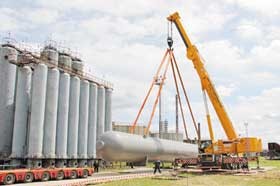
Yulia Ivanova, Head of Heavy and Oversize Cargo Transportation Department, TELS Group of Companies
Transportation of heavy and oversize cargoes is one of the most complex types of transportation, where knowledge, experience and the ability to solve non-standard issues are especially important. Expert’s sixth sense is, by the way, very useful in such matters helping foresee different risks, but as the experience has proved the sixth sense works only when there is good professional education.
A customer transporting heavy and oversize cargoes should know certain things in order to reduce the likelihood of unexpected events or unplanned costs. Several tips on what a customer should know to reduce the risks of unexpected events and help the logistics contractor organize the transportation of oversize cargo better are given below.
1. Check the information about the cargo for consistency.
Cargo characteristics specified in technical documentation may not be true to life, especially if the equipment, units or devices have already been in operation, and could have been modernized this or that way. The cargo must be re-measured with all the “sheds”, “canopies” and other parts.
2. Check the cargo for “dual use” and hazard class.
The unit is likely to be classified as a “dangerous cargo” (ADR) if flammable or toxic process liquids have been used during its operation. It is assumed that these liquids remain partially in it and can create danger for people and the environment during transportation.
Sometimes customs authorities can qualify the cargo as “dual-use” (can be used for military purposes), which will also add complications and limitations to export procedures. This usually applies to all kinds of special vehicles, but the industrial equipment can also fall into this category. We recommend consulting experts in such case.
3. Prepare for the fact that the shortest path may not be applicable for cargo transportation.
Transportation of oversize and heavy cargoes is always special as it requires a detailed delivery scheme taking into account individual characteristics of the cargo. The heavier and the more non-standard the cargo is, the fewer:
- ports can accept and reload it;
- vehicles can carry it;
- roads can be used to carry it;
- bridges, overpasses and other road structures can be missed.
It usually takes more time than planned to develop the route. However, the more detailed the route is, the faster all the required permissions will be collected and the more exact transportation time will be.
One of the remarkable transportation cases in TELS is the delivery of three containers for liquid nitrogen storage from Poland to the oil refinery in Belarus. The dimensions of the objects were 33 m long, 3.17 m wide, 4.15 m high. The weight of one container was 104 tons.
 After a detailed survey of the routes, we found out that 3 (!) preliminarily routes suitable for direct delivery from Poland to Belarus had to be excluded consistently as road construction works were held there at the time. Only the fourth route implying transit transportation via Ukraine was suitable for cargo delivery.
After a detailed survey of the routes, we found out that 3 (!) preliminarily routes suitable for direct delivery from Poland to Belarus had to be excluded consistently as road construction works were held there at the time. Only the fourth route implying transit transportation via Ukraine was suitable for cargo delivery.
Further, it was necessary to obtain the required permits for transportation of oversize and heavy cargo, coordinate the schedule of cargo movement with road services and traffic police of three countries. Sometimes this process takes several months. Professional preparation of the documents to apply and the established business ties allowed to reduce the time – the transportation started in a little more than a month since the documents had been submitted for approval.
The car carrying the cargo was almost 5 meters high. A number of technological solutions had to be developed for successful transportation on individual parts of the road. In particular, light towers and traffic lights were dismantled several times with their subsequent reinstallation. The construction of transport platforms was changed temporarily in order to carry the cargo under one of the lowest bridges along the route.
***
There are still a lot of unique features and “pitfalls” to be taken into account by a logistics contractor, so the last tip is to trust the transportation of heavy and oversize cargo to an experienced and reliable partner.
For anyone interested, I suggest watching a video where the main characteristics of a reliable contractor transporting heavy and oversize cargoes are discussed.
To learn more about heavy and oversize cargo transportation, send a request to or contact with questions –
Yulia Ivanova, Head of Heavy and Oversize Cargo Transportation Department, TELS Group of Companies
Tel: +375-17-210-49-31 (ext. 1056)
Skype: Julia.ivanova20
E-mail: j.ivanova@telsgroup.by